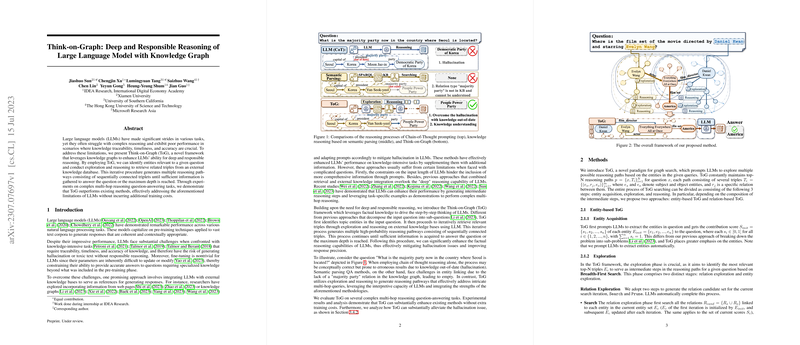Introduction
LLMs are quickly becoming adept at generating coherent and context-appropriate responses across a variety of tasks. Despite their advances, challenges emerge when LLMs are tasked with complex reasoning that demands a deep understanding of factual knowledge. LLMs may generate inaccurate or outdated responses or engage in "hallucination" – providing seemingly confident answers that are unrelated to reality. Moreover, training LLMs can be resource-intensive and does not ensure current knowledge due to the static nature of training datasets.
To enhance the reasoning capabilities of LLMs and keep their knowledge current, integration with external knowledge repositories like knowledge graphs (KGs) presents a promising solution. Prior approaches to integrating LLMs and KGs (denoted LLM⊕KG) have improved LLM performance but are limited by their loose-coupling paradigm, resulting in unexploited KG potential. To address this, the paper introduces a new model, the tight-coupling "LLM ⊗ KG" paradigm, which is realized through an approach called Think-on-Graph (ToG).
Methodology
Think-on-Graph (ToG) capitalizes on LLMs to interactively explore a KB and identify reasoning paths, without additional training. It prompts the LLM to traverse multiple potential reasoning paths on KGs, refining selections iteratively until sufficient information or a set search depth is reached. The selected paths offer a basis for the LLM to perform logical reasoning and yield answers. An extension, ToG-R (Relation-Based Think-on-Graph), focuses on relation chains instead of triples, streamlining reasoning by emphasizing the relevance of relations to the question over the entities themselves.
The process has three key phases:
- Initialization: Utilizing LLMs to identify initial entities related to the query.
- Exploration: Directing LLMs to search for and prune relevant relations and entities within the KG.
- Reasoning: Prompting LLMs to evaluate current reasoning paths for sufficiency in providing an answer. If inadequate, the model loops back through exploration and reasoning until sufficient information is accumulated or a set search boundary is hit.
Advantages and Experimentation
Experiments show several advantages of ToG:
- Enhanced deep reasoning through multi-hop paths.
- Knowledge traceability and correctability due to explicit, editable paths.
- Flexibility in applying various LLMs and KGs.
- Efficiency in updating LLMs with KGs, and improved generality without training costs.
In tests, even when built on smaller LLMs like LLAMA2-70B, ToG's performance matches or surpasses that of larger LLMs like GPT-4 in specific scenarios, suggesting a cost-effective alternative for deploying LLMs.
Conclusion
The Think-on-Graph approach demonstrates state-of-the-art (SOTA) performance across various datasets and tasks, showcasing its potent mix of generality, efficiency, and reasoning ability. Harnessing both structured, editable KGs and the powerful reasoning ability of LLMs, ToG advances the effectiveness of LLMs in knowledge-intensive tasks, offering a compelling solution to the problem of knowledge hallucination. Furthermore, by providing an avenue for knowledge traceability and correctability, ToG aligns with the goal of responsible AI development.
